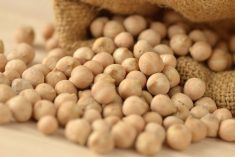CNS Canada — Pulse growers are facing new questions on the Prairies these days as a trade impasse with India forces many farmers to prepare for new market realities.
Prime Minister Justin Trudeau next week will visit India, where the thorny subject of its levies on Canadian pulse exports will be raised.
India imposed the restrictions last fall, which immediately put pressure on pulse-exporting nations, including Canada.
“India takes 40 per cent of Canada’s total pulse exports,” said Carl Potts, executive director of Saskatchewan Pulse Growers.
Read Also

U.S. grains: Corn, soybeans higher in technical bounce; wheat firms
Chicago | Reuters – Chicago corn futures rose modestly on Thursday on chart-based buying, firm cash markets and reminders of…
“There’s no question that when the tariff on peas came on — they dropped 25 per cent overnight,” said Corey Loessin, the group’s chairman. He estimated the market for yellow peas dropped, from $8.50 a bushel to $6.
There was slightly less impact on lentils and chickpeas when the next wave of tariffs came a month later, he said, but it was mostly because growers were expecting it.
“There also wasn’t a lot of trade happening with India at that point.”
Red lentils are currently going for 18 cents/lb., down from a range of 20 to 25 cents earlier in the year, Loessin said. The carryover for red lentils was quite large, though, so it will likely keep rallies to a minimum moving forward.
“It could possibly take a couple of years for the market to bounce back to its historic range,” he said.
In chickpeas, the impact of the tariffs has been less pronounced.
“There’s quite a market for Canadian chickpeas in the U.S., so it was less of an impact for them,” he said.
Fortunately, since the tariffs were announced, China has bought more yellow peas than it normally does.
“They’re kind of on track to buy more than they did the year before,” Loessin said. “That will certainly take up some of the excess India would have bought.”
Fractionation plants are also being established on the Prairies; the first one is already up and running near Saskatoon.
When all of them are running full steam, Loessin said, they will collectively be the third largest market for yellow peas.
“Once they come onstream that could be 600,000 tonnes per year of new demand for yellow peas,” Potts said. “We think that’s very positive.”
Loessin also worries farmer returns will be impacted if Canada can’t get its product shipped to foreign destinations in a quicker fashion.
“If we had a full market in India we would have a challenge getting the product out to the host,” he said, adding railway performance needs to be quicker and waiting times for ships has to shorten.
For the coming crop year, Potts estimates acreage could be down in Saskatchewan by 20-25 per cent.
Loessin agreed acreage will be lower — with a few possible exceptions. “Green lentil acres may actually increase a little bit,” he said.
— Dave Sims writes for Commodity News Service Canada, a Glacier FarmMedia company specializing in grain and commodity market reporting. Follow CNS Canada at @CNSCanada on Twitter.















